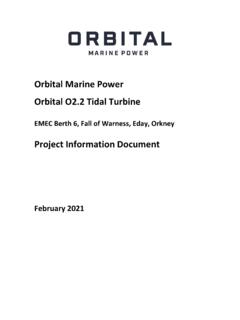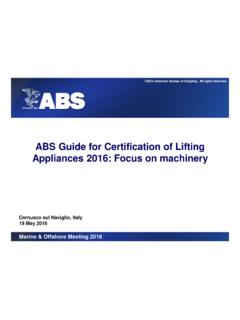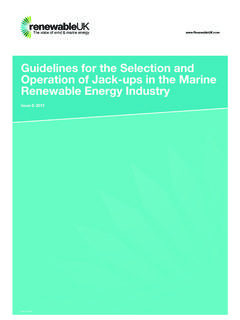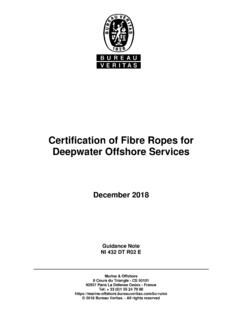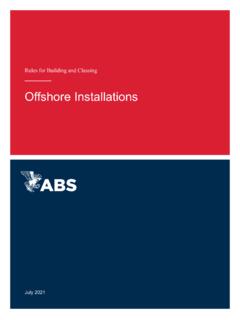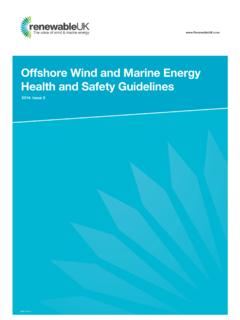Transcription of Offshore Structure Design And Construction
1 UNESCO EOLSSSAMPLE CHAPTERSSHIPS AND Offshore STRUCTURES Offshore Structure Design And Construction Paul A Frieze Encyclopedia of Life Support Systems (EOLSS) Offshore Structure Design AND Construction Paul A Frieze PAFA Consulting Engineers, UK Keywords: Jacket structures, topsides, Design , Construction , metocean, geotechnical, loads, load combinations, piling, Offshore foundations, corrosion protection Contents 1. Introduction 2. Types of Offshore Structures 3. Functional Requirements 4. Fundamental Design Requirements 5. Meteorological and Oceanographical Information 6. Geotechnical Information 7. In-Service and Temporary Design Situations 8. Loading Categories 9. Loading Combinations 10. Structural Analysis 11. Materials and Welding 12. Topsides Design 13. Jacket Design 14. Piling and Foundation Design 15. Introduction to Corrosion Protection Glossary Bibliography Biographical Sketch Summary Structures deployed Offshore for oils and gas field development are reviewed and their functional needs defined.
2 Fundamental Design requirements for fixed steel structures, in particular, those for jackets and topsides, are spelt out together with the expectations of metocean and geotechnical surveys. Temporary and in-service Design requirements, involving appropriate loads and combinations, are defined as well as the demands for structural analysis and materials and welding. Topsides and jacket Design needs are presented in some detail and pile and other foundation assessments described. Basic corrosion protection requirements are reviewed. 1. Introduction Offshore structures have developed rapidly over the last three to four decades. Much of this has been driven by the need to exploit deeper waters as a result of depletion of shallow water easy-to-reach fields, buoyed by a generally continually rising price of oil and, more recently, gas.
3 On occasions, however, serious falls in the oil price have punctured these developments sometimes significantly, leading to major consolidation within the industry. UNESCO EOLSSSAMPLE CHAPTERSSHIPS AND Offshore STRUCTURES Offshore Structure Design And Construction Paul A Frieze Encyclopedia of Life Support Systems (EOLSS) This need for deepwater developments and, as well, a desire to continue to exploit depleting shallow water reserves has spawned new forms of Offshore structures for production, such as production semi-submersibles, tension leg platforms in a variety of shapes and sizes, monohulls (ship-shaped units), spars, monotowers, and production jack-ups. Jackets have continued to be exploited in a variety of ways using different Construction methods, all aimed at speeding up Design , fabrication and installation.
4 2. Types of Offshore Structures Overview There are two main categories of Offshore structures, fixed and floating. Each has a number of sub-categories see Table 1 which also lists their uses, advantages and disadvantages. subsea completions are also structures that are placed on the seafloor basically to support equipment. They are, however, not usually considered to be an Offshore Structure in the generally accepted use of the term. Structure sub-categories Uses Advantages Disadvantages Fixed steel structures Jacket - see Figure 1 Drilling, production Very common, well proven, dry trees No storage, WD1) < 100 m Tower - see Figure 2 Drilling, production Very common, well proven, dry trees No storage, WD 400 m Jack-up - see Figure 3 Drilling, production (few)
5 Common, well proven for production, dry treesNo storage, water depth < 100 m, foundation stability issues Compliant tower - see Figure 4 Drilling, production Dry trees, large no of wells, large payload No storage, current maxm 535 m up to 1000 m, large heavy Structure in deep water Gravity Structure - see Figure 5 Drilling, production Storage, dry trees WD 300 m Monotower - see Figure 6 Drilling, production Unmanned, well proven, dry trees No storage, limited number of wells, WD < 100 m Floating steel structures Monohull - see Figure 7 Production Early production, storage, well proven, large variation in payload, large deck space, deep water WD current maxm 1850 m up to 3000 m, wet trees, sensitive to motions Semi-submersible - see Figure 8 Drilling, production Early production, low heave motion, well proven, dry trees WD current maxm 2440 m up to 3000 m, no storage, wet trees Tension leg platform Drilling, production, Dry trees, roll, pitch & heave negligible, WD current maxm 1450 m up to 1500 m, , UNESCO EOLSSSAMPLE CHAPTERSSHIPS AND Offshore STRUCTURES Offshore Structure Design And Construction Paul A Frieze Encyclopedia of Life Support Systems (EOLSS) - see Figure 9 dry trees several varieties no storage, sensitive to changes in payload Spar - see Figure 10 Drilling, production, storage (limited) Dry trees WD current maxm 1700 m up to 3000 m, roll, pitch & heave significant Table 1.
6 Categories of fixed and floating Offshore structures their uses, advantages and disadvantages Each of these units is considered in turn in the following subsections. Jacket A jacket is a welded tubular space frame with three or more near vertical tubular chord legs with a bracing system between the legs. The jacket provides support for the foundation piles, conductors, risers, and other appurtenances. A jacket foundation includes leg piles which are inserted through the legs (Figure 1) and connected to the legs either at the top, by welding or mechanical means, or along the length of the legs, by grouting. Figure 1. Jacket showing driving of pile through jacket leg UNESCO EOLSSSAMPLE CHAPTERSSHIPS AND Offshore STRUCTURES Offshore Structure Design And Construction Paul A Frieze Encyclopedia of Life Support Systems (EOLSS) Additional piles, called skirt piles, can be inserted through and connected to sleeves at the base of the Structure .
7 Leg and skirt piles jointly anchor the Structure and transfer both vertical and horizontal actions to the seabed. Where the piles are only connected to the legs at the jacket top, the forces are transferred to the piles at the connection and the jacket hangs from the piles. Where the piles are connected by full length grouting, the jacket behavior is similar to that of a tower (Section ), with the legs and piles acting together as composite components. Tower The tower is also a welded tubular space frame with three or more near vertical tubular chord legs with a bracing system between the legs. The tower provides support for the topsides, conductors, risers and other appurtenances. Figure 2. Tower Structure showing cluster piles A tower foundation usually includes cluster piles which are inserted through and connected to sleeves around the corner legs at the base of the Structure (Figure 2).
8 Additional piles, called skirt piles, can be inserted through and connected to sleeves at the UNESCO EOLSSSAMPLE CHAPTERSSHIPS AND Offshore STRUCTURES Offshore Structure Design And Construction Paul A Frieze Encyclopedia of Life Support Systems (EOLSS) base and along the perimeter of the Structure . As an alternative to piles, a tower can be supported by another foundation system that supports it at its base, such as bucket foundations. Cluster and skirt piles, or other foundation system, anchor the Structure and transfer both vertical and horizontal actions to the seabed. The global behavior of a tower is that of a vertical cantilever with all actions being transferred to the foundation system at the base of the tower. Jack-Up Figure 3. Jack-ups in the elevated positions UNESCO EOLSSSAMPLE CHAPTERSSHIPS AND Offshore STRUCTURES Offshore Structure Design And Construction Paul A Frieze Encyclopedia of Life Support Systems (EOLSS) A jack-up comprises a floating hull and three or more legs, which can move up and down relative to the hull.
9 It reaches its operational mode by lowering the legs to the sea floor and then raising the hull to the required elevation. The legs can be moved independently and are supported at their bottom ends by spudcans (Figure 3). Prior to raising the hull, the spudcans are pressed into seabed, a process termed preloading . Preloading pre-compresses the soil so as to reduce the chance of punch-through which, if it occurs, can partly or fully destabilize the platform. The majority of jack-ups are built for short-term operation at different locations around the world. As metocean and foundation conditions vary between locations, such jack-ups have to be assessed for each particular location. A few jack-ups are purpose-built for production at a single location, although there can be the intent for eventual their reuse at other locations. Compliant Tower A compliant tower is a flexible Structure with flex elements (principally flexible legs or axial tubes) to control mass and stiffness characteristics so as to mitigate the effects of periodic wind, wave and current forces.
10 Natural periods are usually greater than 25 sec so they are generally well outside wave periods. Figure 4. Compliant tower UNESCO EOLSSSAMPLE CHAPTERSSHIPS AND Offshore STRUCTURES Offshore Structure Design And Construction Paul A Frieze Encyclopedia of Life Support Systems (EOLSS) Compliant towers are relatively slender compared with jacket/tower structures but have higher installation costs and use a considerable amount of steel. They can support a large number of wells (> 40), with dry trees, and can sustain a large payload (Figure 4). Gravity Structure Gravity structures (or gravity-based structures as they are often termed) are fixed structures that are held in-place against environmental actions solely by their weight plus that of any contained ballast, together with foundation resistance resulting from their weight and lateral resistance from any skirts.










